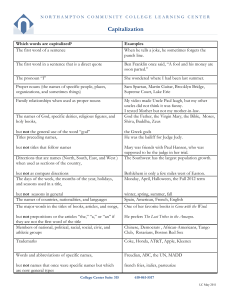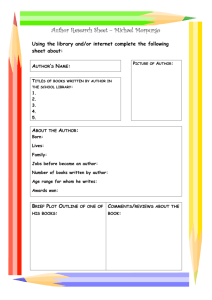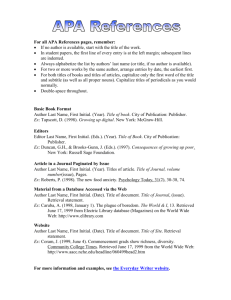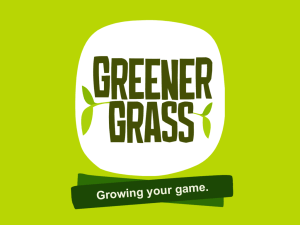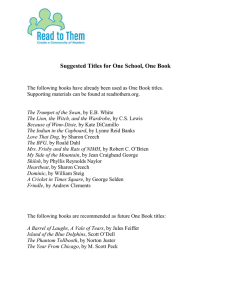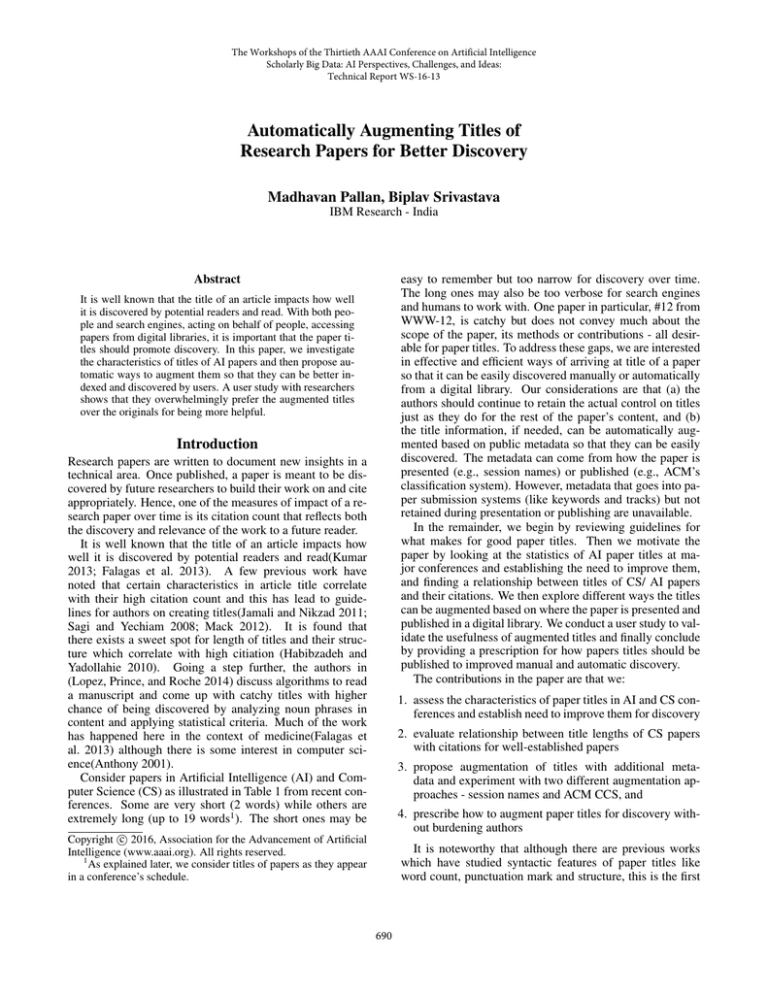
The Workshops of the Thirtieth AAAI Conference on Artificial Intelligence
Scholarly Big Data: AI Perspectives, Challenges, and Ideas:
Technical Report WS-16-13
Automatically Augmenting Titles of
Research Papers for Better Discovery
Madhavan Pallan, Biplav Srivastava
IBM Research - India
Abstract
easy to remember but too narrow for discovery over time.
The long ones may also be too verbose for search engines
and humans to work with. One paper in particular, #12 from
WWW-12, is catchy but does not convey much about the
scope of the paper, its methods or contributions - all desirable for paper titles. To address these gaps, we are interested
in effective and efficient ways of arriving at title of a paper
so that it can be easily discovered manually or automatically
from a digital library. Our considerations are that (a) the
authors should continue to retain the actual control on titles
just as they do for the rest of the paper’s content, and (b)
the title information, if needed, can be automatically augmented based on public metadata so that they can be easily
discovered. The metadata can come from how the paper is
presented (e.g., session names) or published (e.g., ACM’s
classification system). However, metadata that goes into paper submission systems (like keywords and tracks) but not
retained during presentation or publishing are unavailable.
In the remainder, we begin by reviewing guidelines for
what makes for good paper titles. Then we motivate the
paper by looking at the statistics of AI paper titles at major conferences and establishing the need to improve them,
and finding a relationship between titles of CS/ AI papers
and their citations. We then explore different ways the titles
can be augmented based on where the paper is presented and
published in a digital library. We conduct a user study to validate the usefulness of augmented titles and finally conclude
by providing a prescription for how papers titles should be
published to improved manual and automatic discovery.
The contributions in the paper are that we:
It is well known that the title of an article impacts how well
it is discovered by potential readers and read. With both people and search engines, acting on behalf of people, accessing
papers from digital libraries, it is important that the paper titles should promote discovery. In this paper, we investigate
the characteristics of titles of AI papers and then propose automatic ways to augment them so that they can be better indexed and discovered by users. A user study with researchers
shows that they overwhelmingly prefer the augmented titles
over the originals for being more helpful.
Introduction
Research papers are written to document new insights in a
technical area. Once published, a paper is meant to be discovered by future researchers to build their work on and cite
appropriately. Hence, one of the measures of impact of a research paper over time is its citation count that reflects both
the discovery and relevance of the work to a future reader.
It is well known that the title of an article impacts how
well it is discovered by potential readers and read(Kumar
2013; Falagas et al. 2013). A few previous work have
noted that certain characteristics in article title correlate
with their high citation count and this has lead to guidelines for authors on creating titles(Jamali and Nikzad 2011;
Sagi and Yechiam 2008; Mack 2012). It is found that
there exists a sweet spot for length of titles and their structure which correlate with high citiation (Habibzadeh and
Yadollahie 2010). Going a step further, the authors in
(Lopez, Prince, and Roche 2014) discuss algorithms to read
a manuscript and come up with catchy titles with higher
chance of being discovered by analyzing noun phrases in
content and applying statistical criteria. Much of the work
has happened here in the context of medicine(Falagas et
al. 2013) although there is some interest in computer science(Anthony 2001).
Consider papers in Artificial Intelligence (AI) and Computer Science (CS) as illustrated in Table 1 from recent conferences. Some are very short (2 words) while others are
extremely long (up to 19 words1 ). The short ones may be
1. assess the characteristics of paper titles in AI and CS conferences and establish need to improve them for discovery
2. evaluate relationship between title lengths of CS papers
with citations for well-established papers
3. propose augmentation of titles with additional metadata and experiment with two different augmentation approaches - session names and ACM CCS, and
4. prescribe how to augment paper titles for discovery without burdening authors
c 2016, Association for the Advancement of Artificial
Copyright Intelligence (www.aaai.org). All rights reserved.
1
As explained later, we consider titles of papers as they appear
in a conference’s schedule.
It is noteworthy that although there are previous works
which have studied syntactic features of paper titles like
word count, punctuation mark and structure, this is the first
690
S.No.
1
2
3
Conference
AAAI-12
AAAI-12
AAAI-12
Length
2
2
15
4
AAAI-12
18
5
6
7
AAAI-13
AAAI-13
AAAI-13
2
2
17
8
AAAI-13
19
9
10
11
WWW-12
WWW-12
WWW-12
4
4
16
12
WWW-12
17
13
14
15
WWW-13
WWW-13
WWW-13
2
3
17
16
WWW-13
18
Paper Title
Solving Dots-And-Boxes
Weighted Clustering
Parsing Outdoor Scenes from Streamed 3D
Laser Data Using Online Clustering and
Incremental Belief Updates
Design and Optimization of an
Omnidirectional Humanoid Walk: A Winning
Approach at the RoboCup 2011 3D
Simulation Competition
Clustering Crowds
Uncorrelated Lasso
Online Optimization with Dynamic
Temporal Uncertainty : Incorporating Short
Term Predictions for Renewable Integration in
Intelligent Energy Systems
Computational Sustainability Award Winner:
A Temporal Motif Mining Approach to Unsupervised
Energy Disaggregation: Applications to Residential and
Commercial Buildings
Distributed Graph Pattern Matching
Crowdsourcing with Endogenous Entry
Counting Beyond a Yottabyte, or
how SPARQL 1.1 Property Paths will Prevent
Adoption of the Standard
It’s Simply Integral to What I do: Enquiries
into how the Web is Weaved into Everyday Life
Reactive Crowdsourcing
Content-Aware Click Modeling
Is This App Safe for Children? A Comparison
Study on Maturity Ratings on Android and
iOS Applications
I Know the Shortened URLs You Clicked on
Twitter: Inference Attack using Public Click
Analytics and Twitter Metadata
Table 1: Illustration of shortest and longest paper titles from recent AI and CS conferences.
work for AI and CS which also proposes ways to improve
titles and evaluates them in a user study to arrive at a prescription.
rated by a punctuation mark, with each part standing for a
specific aspect of the paper; and full sentences that assert a
major contribution by the paper(Kumar 2013). Nominal and
compound titles are common in computer science.
We note that a paper’s title are used by two different user
groups: (a) humans who search for prior work in digital and
print media, and (b) automated routines in modern digital libraries which use them to build indices to support effective
search interfaces. Humans users prefer short, catchy, precise
titles which they can remember and recall. However, since
words have many synonyms and technical areas evolve over
time, short terms can hamper discovery and degrade search.
For automated search, it is known in asset organization literature that descriptive titles which contain the context of
usage are preferable(Srivastava et al. 2007). But this invariably results in longer asset metadata, i.e., titles here.
For the purpose of the paper, we adopt the guidelines for
paper titles to be that they:
What Makes For a Good Paper Title?
We start by reviewing guidelines for what makes for good
paper titles. The literature gives a diverse spectrum of views.
The authors in (Lopez, Prince, and Roche 2014) note that a
title is syntactically a metadata with a structure that can be
a word, phrase, expression, or sentence, that serves to indicate a paper or one of its parts and give its subject. In
essence, it could be any string but the expectation is for it
to be meaningful with respect to its content. In terms of
what a title should contain, (Kumar 2013) argues that the
title should be captivating and introduce the reader to the
subject of the paper in a clear and concise manner. But what
is concise? A prominent university’s guideline (USC 2014)
is to have 10-15 words while a survey of computer science
papers (Anthony 2001) finds them to be from anywhere in
2-24 range with an average of 9. There are 3 main types
of paper titles: nominal, which describes a paper’s theme;
compound, which has title made up of multiple parts sepa-
• should be between 5-15 words long
• should have standard terms that help automatic indexing
• should convey the subject of the paper
691
S.No.
Papers
Titles
Titles
(w/o SW)
Unique Words
Unique Words
(w/o SW)
AAAI
-2012
294
(2,18
,7.918)
(2,13)
,6.316
1090
1074
AAAI
-2013
254
(2,19
,8.244)
(2,15)
,6.5
993
976
WWW
-2012
107
(4,17
,8.355)
(2,13)
,6.551
512
496
WWW
-2013
125
(2,18
,9.104)
(1,15)
,7.096
586
568
puter science and AI. To do so, we obtained the authors and
citation counts from Google Scholar5 as on 13 August 2014.
In Figure 1, title lengths of paper by the 10 highest cited authors in CS are shown along with the total. The plots have
titles with and without commonly used words (stop words),
in left and right, respectively.
In Figure 3 and Table 4, the citation data for the top10 authors and total are fitted to a sinusoidal function a1 sin(b1 x + c1 ) + a2 sin(b2 x + c2 ). Also shown is the RSquare values which is a statistical measure showing how
successful the fit is in explaining the variation of the data.
Mathematically, it is defined as the ratio of the sum of
squares of the regression (SSR) and the total sum of squares
(SST). R-square can take on any value between 0 and 1, with
a value closer to 1 indicating that a greater proportion of
variance is accounted for by the model. Thus, an R-square
value of 0.8907 means that the fit explains 89.07% of the
total variation in the data about the average. The R-squared
value shows that the curve fit to sinusoidal is, in general,
quite good. Further, the highly cited papers were typically
of length 2-10 words.
Table 2: Overall statistics about papers in the dataset. Numbers in bracket represent (min,max,avg) and w/o SW denotes
without stop words.
• may be catchy to help humans recall it later
Paper Titles in CS and AI
We now investigate the nature of paper titles in major conferences and their characteristics in highly cited papers. This
will set the stage for motivating automatic augmentation of
paper titles for discovery.
Discussion
From the papers in two major conferences over 2 years, we
found that the papers can have a wide diversity in title length
(2-19) and an average of about 8 words. To the extent highly
cited papers provide clues to how to name papers, they suggest short titles of length 2-10 words. Finally, guidelines
on writing good paper titles recommend using 5-15 words
which are relevant to the scope of the paper.
We now consider how to augment paper titles. This would
be especially helpful for the case where the title is too short
or not relevant to its material, but we still want to promote
discovery.
Paper Titles in CS/ AI Conferences
We considered the papers published in two major conferences for two years (2012-2013): Association for the Advancement for Artificial Intelligence (AAAI) conference,
which is the premier AI conference(AAAI 2012; 2013),
and World Wide Web (WWW) conference(WWW 2012;
2013), where papers appear from both AI and other CS disciplines. The information about papers in these conferences
are available at multiple fora but with different, overlapping,
metadata. Since we were interested in both paper details
and how they were grouped together for presentation, we
used the cited online sources. Here, the titles of the papers
are extracted and then analyzed as-is and also after extracting common words called stopwords2 . The tools used were
JSoup3 for extraction and R for statistical analysis4 .
Table 2 gives the overall statistics for the papers appearing
in these conferences. The total number of papers are 780
which is more than papers analyzed in previous studies like
(Anthony 2001) (600 papers). The title lengths varied from
2-19 with an average of about 8 words, not accounting for
stop words, and 1-15 with an average of about 7 words when
they are considered. The most frequent 5 words in the titles
are shown in Table 3. They reflect the AI and web focus of
the AAAI and WWW conferences, respectively.
Automatically Augmenting Paper Titles
In this section, we show how titles can be automatically
augemented to promote meaningful discovery. We refer to
the orginal paper titles as Original. The new content comes
from the conferences’ session names and ACM classification of Computer Science discipline, which are sometimes
different but metadata authors put in conference paper submission systems but are not retained thereafter.
Augmenting Titles with Session Names
After research papers are accepted for publication, they are
scheduled for presentation. Conferences differ in how they
group papers into different sessions for oral or poster presentation or both, but are uniform in assigning additional metadata to label the groups in which the papers get presented.
We use the term session name to refer to presentation group
names. Since program organizers have already considered
the paper’s content and reviews to group them and assign
meaningful names, they are good candidates for metadata to
augment paper titles.
For our work, we used the schedule of technical program
of conferences as our data source. The Jsoup library came
Paper Titles and Citations
Since papers are written to be discovered and cited, we now
look at the nature of some of the highest cited papers in com2
Stopwords used are: A, AN, THE, FOR, AND, NOR, BUT,
OR, YET, SO, IN, ON, OF, UNDER, ABOVE, ABOUT, AT, BEHIND, FROM, OPPOSITE, UPON, TILL, THROUGH, SINCE,
AROUND, ALONG, INTO, WITH, BY, TO.
3
http://www.jsoup.org
4
http://www.r-project.org/
5
692
http://www.googlescholar.com
Title Length v/s Citation Count
Total
Alan Turing
Allen Newell
Herbert Simon
Jim Hendler
Judea Pearl
Michael I. Jordan
Michael Wooldridge
Sebastin Thrun
Nick Jennings
Lofti A. Zadeh
13
12
11
10
13
9
8
12
11
10
9
8
7
7
6
6
5
0
2
4
6
8
10
Number of Words
12
14
16
Total
Alan Turing
Allen Newell
HerbertSimon
Jim Hendler
Judea Pearl
Michael I. Jordan
Michael Wooldridge
Sebastin Thrun
Nick Jennings
Lofti A. Zadeh
14
Cumulative Citation Count (log)
14
Cumulative Citation Count (log)
Title Length (without Stop Words) v/s Citation Count
15
15
5
18
0
2
4
6
8
Number of Words
10
12
Figure 1: Length of paper titles and their citations
S.No.
1
2
3
4
5
AAAI-2012
LEARNING (33, 0.112)
USING (25, 0.085)
GAMES (17, 0.058)
MODELS (15, 0.051)
APPROACH (14, 0.048)
AAAI-2013
LEARNING (34, 0.134)
PLANNING (14, 0.055)
SEARCH (14, 0.055)
MODEL (11, 0.043)
VIA (11, 0.043)
WWW-2012
WEB (18, 0.168)
SOCIAL (15, 0.14)
SEARCH (13, 0.121)
NETWORKS (10, 0.093)
INFORMATION (7, 0.065)
WWW-2013
SOCIAL (21, 0.168)
WEB (19, 0.152)
NETWORKS (15, 0.12)
SEARCH (12, 0.096)
ONLINE (11, 0.088)
Table 3: Top 5 words in the Respective Conference. Numbers in bracket represent (#papers, fraction of papers) statistics from
conferences.
very handy in extracting the information. The extracted session names were used as a prefix to the original titles marked
in square brackets. We refer to such paper titles as AugSession.
some threshold. In our experiments, we found Levenshtein
and Cosine to perform the best. Details are omitted due to
page restrictions but we point out a complication. It is how
to navigate the CCS poly-hierarchy because a match to a
node may also match its specialized children. We navigated
the CCS breadth (level-) first and stopped at the first node
that matched.
Once a matching ACM CCS node is found, one could select its label as well as one of more of its descendents. In
order to keep the augmented titles brief, we chose to select
the names of only the matching node and leave exploration
of other choices as future work.
After selecting the ACM metadata, we build the augmented name by prefixing it to the original name. The prefix
is marked in square brackets. We refer the paper titles augmented with ACM 2012 CCS as Aug-ACM.
Augmenting with ACM Classification
Association for Computing Machinery, ACM, the leading computing organization, had developed a classification
scheme for computer science called Computing Classification System (CCS) in 1964 and has since been revising and
maintaining it frequently. The latest version is called 2012
CCS (ACM 2012) and it is a poly-hierarchical ontology used
extensively in ACM’s own digital library. 2012 CCS can be
used for educational and research purposes. Of the two conferences considered, WWW is an ACM conference while
AAAI is not.
In order to augment papers titles with ACM 2012 CCS
terms, the steps followed were:
Discussion
Figure 2 shows the characteristics of the paper titles for the
full dataset for Original, Aug-Session and Aug-ACM with
a lognormal probability density function of the respective
# words in the title. As expected, we see the average title lengths increasing compared to original with Aug-ACM
leading to a lesser increase than Aug-Session. Since ACM is
manually curated as an ontology, the augmented metadata is
expected to be more meaningful as well.
Further, we show the automatic augmentation of the example titles from Table 1 in Table 5. We wanted to see
whether researchers actually prefer augmented paper titles
over original and if so, which among the two we investigated. To do so, we conducted a user study that is described
1. Match: Take session name of papers and match it to 2012
CCS automatically.
2. Select: Select metadata from ACM node and children
3. Build: Decide and build the augmented name
To match session names with ACM CCS, we resort to
string comparison techniques. Let θ(si , sj ) represent the
similarity score of two single contents (strings), si and sj .
There are many choices for θ (Cohen, Ravikumar, and Fienberg 2003; Chapman 2009). We experimented with MongeElkan, Levenshtein, Cosine and Euclidean. Now si is similar to sj , denoted by si ≈ sj , if θ(si , sj ) φ, where φ is
693
AAAI 2012
AAAI 2013
0.2
0.2
Original
Aug − ACM
Aug − Session
0.1
0.05
0
Original
Aug − ACM
Aug − Session
0.15
p
p
0.15
0.1
0.05
2
4
6
8
10
12
No of Words
14
16
18
0
20
2
4
6
8
10
WWW 2012
18
20
22
0.2
Original
Aug − ACM
Aug − Session
0.15
Original
Aug − ACM
Aug − Session
0.15
0.1
p
p
16
WWW 2013
0.2
0.05
0
12
14
No of Words
0.1
0.05
4
6
8
10
12
14
16
No of Words
18
20
22
0
24
0
5
10
15
20
25
No of Words
Figure 2: Augementing titles of papers with session names and ACM classification; latter is shorter.
S.No.
Person Name
Total Citations
1
2
3
4
5
6
7
8
9
10
Allen Newell
Alan Turing
Nicks Jennings
Sebastin Thrun
Jim Hendler
Michael Wooldridge
Herbert Simon
Michael I.Jordan
Lofti A. Zadeh
Judea Pearl
Total
47,261
29,217
28,713
24,287
28,929
32,444
142,985
40,101
107,185
43,398
524,520
R-Squared
Value
0.8907
0.8695
0.8622
0.6889
0.682
0.6696
0.6498
0.583
0.5814
0.541
0.6023
RMSE
2806
2076
1743
1884
5242
5237
7608
3823
97
7277
107
RMSE
% Error
5.9%
7.1%
6.1%
7.7%
18.1%
16.1%
5.3%
9.5%
∼0%
16.7%
∼0%
Table 4: Top 10 authors in CS, their papers’ citation counts and the error values for fit obtained for their papers.
4
Title Length v/s Citation Count
x 10
vey gave a single instruction, ”In the following list of paper
titles, click on the style of paper title given, which you consider the most meaningful if you were to search for them”.
It consisted of paper title set consisting of 16 titles in which
we took 4 titles each from conferences AAAI- 2012, AAAI2013, WWW-2012 and WWW-2013.There were two types
of titles. The first type (Type-1) consisted of 8 titles, each
having three options to select from, which were research title
(Original), research title augmented with session track (AugSession) and research title augmented with ACM 2012 CCS
(Aug-ACM). The second type (Type-2) had 8 titles, each having only 2 options since Aug-Session turned out to be the
same as Aug-ACM . Participants were not told about the type
of titles to avoid any bias in the reply. For each type, the total
number of responses would be 120 (i.e., = 8 x 15).
Number of Words vs. Cumulative Citations
8
Total
Cumulative Citations
7
6
5
4
3
2
1
0
2
4
6
8
10
Number of Words
12
14
16
Figure 3: Sinusoidal curve fitted to plot relating total citations to title lengths.
The result is shown in Figure 4. Here, the count of votes
of respondents is shown on the Y-axis for Type-1 and Type2 titles on left and right, respectively. In Type-1, we see
that 75% of the responses preferred augmented titles over
the original (25%), and this was made up of 42% preferring
Aug-ACM and 33% liking Aug-Session. In Type-2, we see
that 62% of the responses preferred augmented titles over
the original (38%).
next.
User Study and Discussion
We conducted an online survey with a random group of participants consisting of researchers and advanced developers
of an industrial research organization working in Information Technology-based solutions and services. The AI research experience of participants ranged from 1-20 years. A
total of 15 participants participated in the survey. The sur-
The user study, although limited in size, shows that augmented paper titles are preferrable than original titles for discovery, and among the two types of augmentation, adding
694
Table 5: Select papers with original titles as well as when augmented with conference’s session names and ACM classification,
respectively.
695
WWW-2012
WWW-2012
WWW-2012
WWW-2012
WWW-2013
WWW-2013
WWW-2013
WWW-2013
WWW-2013
WWW-2013
16
17
18
19
20
21
22
23
24
AAAI-2013
12
15
AAAI-2013
11
WWW-2012
AAAI-2013
AAAI-2013
AAAI-2013
AAAI-2013
7
8
9
10
14
AAAI-2012
6
WWW-2012
AAAI-2012
AAAI-2012
AAAI-2012
AAAI-2012
AAAI-2012
1
2
3
4
5
13
Conference
S.No.
Reactive Crowdsourcing
Content-Aware Click Modeling
Pick-A-Crowd: Tell Me What You Like, and
Ill Tell You What to Do
Is It Time for a Career Switch
Is This App Safe for Children?
A Comparison Study on Maturity Ratings
on Android and iOS Applications
I Know the Shortened URLs
You Clicked on Twitter: Inference Attack
using Public Click Analytics and
Twitter Metadata
It’s Simply Integral to
What I do”: Enquiries into how the Web is
Weaved into Everyday Life”
Counting Beyond a Yottabyte, or how SPARQL 1.1
Property Paths will Prevent Adoption
of the Standard
Your Two Weeks of Fame and your Grandmother’s
Trains of Thought: Generating Information Maps
Distributed Graph Pattern Matching
Crowdsourcing with Endogenous Entry
[Social Web Engineering] Reactive Crowdsourcing
[Web Mining] Content-Aware Click Modeling
[Social Web Engineering] Pick-A-Crowd: Tell Me
What You Like, and Ill Tell You What to Do
[Recommender System] Is It Time for a Career Switch
[Transforming UIs / Personal & Mature Data] Is This App Safe
for Children? A Comparison Study on Maturity Ratings
on Android and iOS Applications
[Privacy and Personalization] I Know the Shortened URLs
You Clicked on Twitter: Inference Attack
using Public Click Analytics and
Twitter Metadata
[Crowdsourcing] Crowdsourcing with
Endogenous Entry
[Data And Content Management] Distributed Graph
Pattern Matching
[Web Mining] Trains of Thought: Generating
Information Maps
[Web Mining] Your Two Weeks of Fame and
your Grandmother’s
[Ontology Representation and Querying : RDF and SPARQL]
Counting Beyond a Yottabyte, or how SPARQL 1.1
Property Paths will Prevent Adoption
of the Standard
[User Interfaces and Human Factors] It’s Simply Integral to
What I do”: Enquiries into how the Web is
Weaved into Everyday Life”
[Classification] Uncorrelated Lasso
[Crowdsourcing] Clustering Crowds
[Privacy and Social Media] Search More, Disclose Less
[Classification] Teaching Classification
Boundaries to Humans
[MDPs and Sequential Processes] Online Optimization with
Dynamic Temporal Uncertainty : Incorporating Short
Term Predictions for Renewable Integration in
Intelligent Energy Systems
[Data Mining] Computational Sustainability Award Winner:
A Temporal Motif Mining Approach to Unsupervised
Energy Disaggregation: Applications to Residential
and Commercial Buildings
[Multiagent Systems] Solving Dots-And-Boxes
[Machine Learning] Weighted Clustering
[Multiagent Systems] On Maxsum Fair Cake Divisions
[Constraints, SAT, & Search] Don’t Be Strict in Local Search!
[Robotics] Parsing Outdoor Scenes from
Streamed 3D Laser Data Using Online
Clustering and Incremental Belief Updates
[Robotics] Design and Optimization of an
Omnidirectional Humanoid Walk: A Winning
Approach at the RoboCup 2011 3D
Simulation Competition
Solving Dots-And-Boxes
Weighted Clustering
On Maxsum Fair Cake Divisions
Don’t Be Strict in Local Search!
Parsing Outdoor Scenes from
Streamed 3D Laser Data Using Online
Clustering and Incremental Belief Updates
Design and Optimization of an
Omnidirectional Humanoid Walk: A Winning
Approach at the RoboCup 2011 3D
Simulation Competition
Uncorrelated Lasso
Clustering Crowds
Search More, Disclose Less
Teaching Classification Boundaries
to Humans
Online Optimization with Dynamic
Temporal Uncertainty : Incorporating Short
Term Predictions for Renewable Integration in
Intelligent Energy Systems
Computational Sustainability Award Winner:
A Temporal Motif Mining Approach to Unsupervised
Energy Disaggregation: Applications to Residential
and Commercial Buildings
Paper Title Augmented with Session Name
Paper Title
[Web and social media search] Reactive Crowdsourcing
[Web Mining] Content-Aware Click Modeling
[Web and social media search] Pick-A-Crowd: Tell Me
What You Like, and Ill Tell You What to Do
[Recommender Systems] Is It Time for a Career Switch
[User interface programming] Is This App Safe for
Children? A Comparison Study on Maturity Ratings
on Android and iOS Applications
[Personalization] I Know the Shortened URLs
You Clicked on Twitter: Inference Attack
using Public Click Analytics and
Twitter Metadata
[Crowdsourcing] Crowdsourcing with
Endogenous Entry
[Content analysis and feature selection] Distributed
Graph Pattern Matching
[Web Mining] Trains of Thought: Generating
Information Maps
[Web Mining] Your Two Weeks of Fame and
your Grandmother’s
[Ontology engineering] Counting
Beyond a Yottabyte, or how SPARQL 1.1
Property Paths will Prevent Adoption
of the Standard
[User studies] It’s Simply Integral to
What I do”: Enquiries into how the Web is
Weaved into Everyday Life”
[Classification and regression trees] Uncorrelated Lasso
[Crowdsourcing] Clustering Crowds
[Social media] Search More, Disclose Less
[Classification and regression trees] Teaching
Classification Boundaries to Humans
[Markov decision processes] Online Optimization with
DynamicTemporal Uncertainty : Incorporating Short
Term Predictions for Renewable Integration in
Intelligent Energy Systems
[Data Mining] Computational Sustainability Award Winner:
A Temporal Motif Mining Approach to Unsupervised
Energy Disaggregation: Applications to Residential
and Commercial Buildings
[Multiagent Systems] Solving Dots-And-Boxes
[Machine Learning] Weighted Clustering
[Multiagent Systems] On Maxsum Fair Cake Divisions
[Search interfaces] Don’t Be Strict in Local Search!
[Robotics] Parsing Outdoor Scenes from
Streamed 3D Laser Data Using Online
Clustering and Incremental Belief Updates
[Robotics] Design and Optimization of an
Omnidirectional Humanoid Walk: A Winning
Approach at the RoboCup 2011 3D
Simulation Competition
Paper Title Augmented with ACM CCS
Questions with Three Options
Questions with Two Options
60
80
70
50
Vote Count of Respondents
Vote Count of Respondents
60
40
30
20
50
40
30
20
10
10
0
Original
Aug − Session
0
Aug − ACM
Original
Aug − Session / Aug − ACM
Figure 4: User Study on Augmenting Titles
Conclusion
metadata from ACM 2012 CCS is preferred. Once the survey was completed, we revealed the source of paper titles to
the participants and presented the results. The researchers
agreed that ACM 2012 CCS is preferred for augmenting paper titles even if the papers are not part of an ACM conference since they bring uniformity in metadata while session
names can vary.
Research papers are written to be discovered, read and cited.
It is well known that the title of an article impacts how well it
is discovered by potential readers. In this paper, we explored
characteristics of titles of AI papers and that of highly cited
papers and compared them with recommended guidelines.
We found that although good and well cited paper titles have
word length in narrow range that promotes recall, the AI
papers can have a wide diversity. To improve title quality
and make them more amenable for search, we investigated
automatic augmentation of titles using session names of the
conferences in which they appeared and well as from ACM
classification. We experimented with a user group and found
that they overwhelmingly prefer the augmented titles over
the originals for being more helpful with search.
Prescription for Organizing Conference Papers in
Digital Libraries
A research paper’s worth to future readers depends on its
content. However, the title of a paper helps it to be quickly
discovered and hence must be meaningful. Augmenting paper titles particularly helps papers which have (a) very short
titles, (b) long catchy titles but not directly relevant to the
content of the paper.
To augment titles, one can use metadata from paper submission like keywords and topics of interest; presentation
like session names, and publication like ACM 2012 CCS.
Usually, submission metadata is captured in conference
management systems but lost thereafter. Session names are
particular to each conference and can become inconsistent
over time. A classification scheme like CCS offers stability
across conferences and is thus preferred. In our limited user
study, participants (researchers) prefered CCS over session
names.
We now use the insights to prescribe how paper titles
should be organized. If the paper appears in an ACM conference, its CCS classification is available during submission and publication. We suggest that available CCS should
directly be added to titles of papers by indexing organizations to improve discovery. But for non-ACM conferences,
which includes a wide variety of AI papers, one may not
have paper submission metadata and only be left with session names. Fortunately, one can map session names to CCS
and use the corresponding closest CCS labels to effectively
augment titles.
References
AAAI. 2012. Aaai-12 schedule. http://www.aaai.org/
Conferences/AAAI/2012/aaai12schedule.pdf.
AAAI. 2013. Aaai-13 schedule. http://www.easychair.org/
smart-program/AAAI-13/index.html.
ACM. 2012. 2012 acm computing classification system. In
http://dl.acm.org/ccs flat.cfm.
Anthony, L. 2001. Characteristic features of research article
titles in computer science. In IEEE Transactions on Professional Communication, Vol. 44, pp.187-194.
Chapman, S. 2009. Simmetrics. http://www.dcs.shef.ac.uk/
∼sam/stringmetrics.html.
Cohen, W.; Ravikumar, P.; and Fienberg, S. 2003. A comparison of string metrics for matching names and records.
In KDD Workshop on Data Cleaning and Object Consolidation, volume 3.
Falagas, M. E.; Zarkali, A.; Karageorgopoulos, D. E.; V,
V. B.; and Mavrose, M. N. 2013. The impact of article length
on the number of future citations: a bibliometric analysis of
general medicine journals. In PLoS One, Vol.8(2), p.e49476.
696
Habibzadeh, F., and Yadollahie, M. 2010. Are shorter article
titles more attractive for citations? cross-sectional study of
22 scientific journals. In Croatian Medical Journal, Vol. 51,
No. 2, pp. 165170.
Jamali, H. R., and Nikzad, M. 2011. Article title type and its
relation with the number of downloads and citations. In Scientometrics, online first. DOI: 10.1007/s11192-011-0412-z.
Kumar, M. J.
2013.
Making your research paper discoverable:
Title plays the winning trick.
http://mamidala.wordpress.com/2013/08/11/making-yourresearch-paper-discoverable-title-plays-the-winning-trick.
Accessed 13 Aug 2014.
Lopez, C.; Prince, V.; and Roche, M. 2014. How can catchy
titles be generated without loss of informativeness? In Expert Systems with Applications, 41 (4) : 1051-1062.
Mack, C.
2012.
How to write a good scientific
paper: title, abstract, and keywords.
In Journal of
Micro/Nanolithography, MEMS, and MOEMS, Vol.11(2),
pp.020101-1 020101-4.
Sagi, I., and Yechiam, E. 2008. Amusing titles in scientific journals and article citation. In Journal of Information
Science, Vol. 34, No. 5, pp. 680687.
Srivastava, B.; Ponnalagu, K.; Narendra, N.; and Kannan,
K. 2007. Enhancing asset search and retrieval in a services
repository using consumption contexts. In Services Computing, 2007. SCC 2007. IEEE International Conference on,
316–323.
USC. 2014. Making your research paper discoverable: Title plays the winning trick. In Univ. of Southern California’s paper guideline, At http://libguides.usc.edu/content.
php?pid=83009\&sid=801403. Updated 4 Aug 2014.
WWW. 2012. Www-12 schedule. http://www2012.org/
wwwprogram/getinfo.php?type=technical.
WWW. 2013. Www-13 schedule. http://www2013.org/
program.
697

